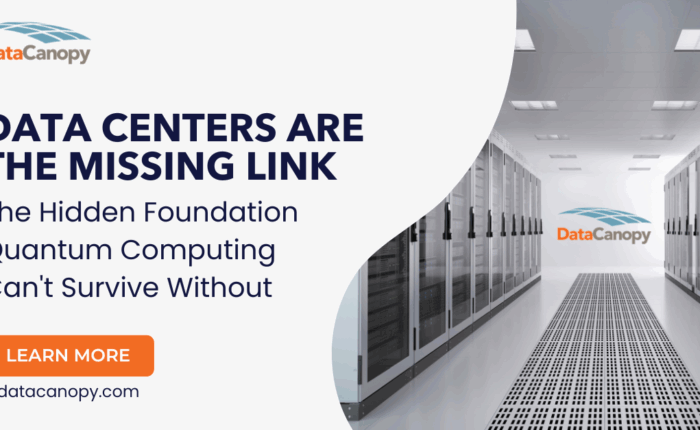High-density colocation is a significant advancement in data center services, specifically designed to support the growing demands of AI and ML workloads. This innovative approach allows for the deployment of powerful computational resources such as GPUs, which are essential for maximizing performance in artificial intelligence applications.
Key features of high-density colocation include:
- Enhanced Performance: Tailored environments manage power and cooling requirements effectively.
- Scalability: Modular infrastructure adapts easily to growing workloads.
- Energy Efficiency: Innovative cooling technologies reduce operational costs.
By leveraging high-density colocation, organizations can achieve superior computational capabilities while maintaining efficiency.
For businesses looking to harness the full potential of their AI infrastructure, understanding the benefits of high-density colocation is an important first step.
To learn more about how Data Canopy’s high-density colocation solutions can drive your AI and ML performance forward, contact us today.
Understanding High-Density Colocation
High-density colocation facilities are specialized environments designed to accommodate the unique needs of high-performance computing, particularly for AI and ML workloads. These facilities stand apart from traditional colocation setups through several key features:
1. Increased Power Density
High-density data centers offer significantly higher power density per rack, allowing for the deployment of powerful GPUs and advanced computing resources. This capability is essential for handling the demanding computational requirements of AI and ML applications.
2. Optimized Space Utilization
The architecture of high-density facilities maximizes space efficiency, enabling organizations to deploy more hardware in a smaller footprint. This is achieved through advanced rack designs that support vertical stacking of equipment, enhancing overall capacity without compromising performance.
3. Advanced Cooling Solutions
Effective cooling is critical in high-density environments due to the heat generated by densely packed servers. Innovative cooling technologies, such as liquid cooling systems, play a pivotal role in maintaining optimal operating temperatures while minimizing energy consumption.
The interplay between power density and physical density is crucial in optimizing performance within these facilities.
- Power Density: Refers to the amount of power supplied per unit area or volume. In high-density colocation, this measurement is elevated to support numerous high-performance devices simultaneously. This ensures that each server operates at peak efficiency without risk of overheating or power shortages.
- Physical Density: Relates to how closely equipment can be installed within a given space. High physical density facilitates greater processing capabilities while maintaining manageable thermal outputs, further enhancing the effectiveness of cooling solutions.
Understanding these aspects enables businesses to appreciate how high-density colocation can transform their approach to deploying AI and ML technologies, setting the stage for maximized performance and scalability.
The Benefits of High-Density Colocation for AI and ML Workloads
High-density colocation provides several crucial advantages for organizations that rely on AI and ML workloads. These benefits directly address the demanding computational requirements of advanced applications.
Enhanced Application Performance
High-density colocation facilities are specifically designed to handle the high power and cooling needs of GPUs. This capability results in:
- Optimized Processing Power: The increased power density allows multiple GPUs to operate simultaneously without performance degradation, ensuring rapid data processing.
- Reduced Latency: Proximity to robust networking options minimizes latency, which is critical for real-time analytics and decision-making in AI applications.
Scalability for Growing Workloads
As businesses expand their use of AI and ML technologies, scalable infrastructure becomes essential. High-density colocation supports this need through:
- Modular Design: Facilities can be easily scaled up or down based on workload demands, allowing organizations to adjust their resources dynamically.
- Support for Diverse Applications: Whether it’s deep learning or big data analytics, high-density environments can accommodate varying workloads seamlessly.
Improved Energy Efficiency
Innovative cooling technologies within high-density colocation centers play a pivotal role in energy management:
- Liquid Cooling Systems: These systems efficiently dissipate heat generated by multiple GPUs, reducing reliance on traditional air-cooling methods. This leads to significant energy savings.
- Lower Operational Costs: Enhanced energy efficiency results in reduced electricity bills, contributing to a smaller environmental footprint while maintaining high-performance levels.
Leveraging these advantages ensures that organizations can effectively manage their AI and ML workloads while enhancing overall productivity. High-density colocation stands as a vital solution that aligns with the evolving demands of advanced computation.
Importance of Connectivity in High-Density Colocation Facilities
In the world of high-density colocation, having strong connectivity is a must. Applications that require high performance, particularly those powered by AI and machine learning (ML), heavily rely on the ability to communicate smoothly with data sources, cloud services, and other computing resources. Here are the key reasons why connectivity is so important in these settings:
1. Low-Latency Access
High-density colocation facilities are designed to minimize latency. Being close to multiple carriers and cloud providers improves real-time data processing capabilities, which is essential for AI algorithms that depend on immediate data retrieval and analysis. This aspect is closely related to edge computing, where data processing happens closer to the source, thereby reducing latency.
2. Diverse Interconnection Options
These facilities offer a variety of networking capabilities, such as direct cross-connects and options for hybrid cloud integrations. This flexibility allows businesses to customize their network architecture according to specific operational needs, ensuring optimal performance.
3. Enhanced Application Performance
With advanced networking technologies in place, organizations can expect improved application responsiveness. Rapid access to large datasets leads to more efficient processing times and better outcomes in AI and ML projects.
By investing in strong connectivity through high-density colocation, organizations not only meet their current requirements but also set themselves up for future growth and technological advancements.
Support for Advanced Applications and Technologies with High-Density Colocation
High-density colocation facilities play a crucial role in the deployment of advanced applications, particularly in the areas of High Performance Computing (HPC), deep learning, and big data analytics. These environments are specifically designed to meet the demanding requirements of modern computational tasks.
Key Benefits of High-Density Colocation for Advanced Applications
- Optimized Infrastructure: High-density colocation centers provide robust power and cooling systems tailored for GPU-intensive tasks. This ensures that deep learning models can be trained efficiently without overheating or power limitations.
- Scalability for Big Data: As organizations increasingly rely on large datasets, the ability to scale infrastructure seamlessly becomes vital. High-density facilities allow businesses to expand their capacity quickly to accommodate growing data processing needs.
- Access to Cutting-Edge Resources: Many high-density colocation providers, like Data Canopy, partner with leading technology firms, granting access to the latest GPU technologies essential for AI and ML initiatives. This availability empowers organizations to leverage innovative solutions without significant upfront investment.
The combination of these features enables organizations to run complex applications effectively, facilitating advancements in AI, machine learning, and data-driven decision-making processes.
Future Trends Shaping the Landscape of High-Density Colocation Services
High-density colocation services are evolving rapidly, influenced by technological advancements and shifting market demands. Notable trends include:
1. Green Data Centers
Sustainability is becoming a priority. Facilities are adopting renewable energy sources and energy-efficient technologies to minimize their carbon footprint. This trend aligns with growing regulatory pressures and corporate social responsibility initiatives.
2. Increased Automation
The integration of AI and machine learning into data center operations enhances efficiency. Automated monitoring systems optimize resource allocation, reducing downtime and improving overall performance.
3. Edge Computing Expansion
As IoT devices proliferate, the need for localized processing grows. High-density colocation facilities are adapting to support edge computing, enabling real-time data processing closer to the source.
4. Hybrid Cloud Solutions
Businesses increasingly seek flexibility in their infrastructure. High-density colocation providers are offering hybrid cloud solutions that seamlessly integrate on-premises and cloud resources, catering to diverse workload requirements.
5. Enhanced Security Measures
With cyber threats on the rise, colocation facilities are investing in advanced security protocols. This includes physical security enhancements and sophisticated cybersecurity measures to protect sensitive data.
These trends indicate a dynamic future for high-density colocation services, positioning them as essential components in the landscape of modern data centers.
Best Practices for Choosing a Reliable High-Density Colocation Provider
Selecting a high-density colocation provider is crucial for optimizing your AI and ML workloads. Consider the following key factors:
- Reliability: Assess the provider’s uptime history and SLAs (Service Level Agreements). Look for certifications such as SSAE 16 or ISO 27001, which indicate adherence to industry standards.
- Scalability: Ensure the facility can accommodate your future growth. A modular design allows for easy expansion of resources without significant downtime.
- Power Density: Verify that the data center supports high power density per rack. This is essential for deploying powerful GPUs effectively.
- Cooling Solutions: Investigate the cooling technologies employed. Advanced systems like liquid cooling can enhance performance while reducing energy costs.
- Connectivity Options: Evaluate the availability of diverse network carriers and cloud providers. This directly impacts latency and redundancy.
- Security Measures: Review physical security protocols, including biometric access controls and surveillance systems. Protecting sensitive data is paramount.
- Support Services: Consider the support level offered, including technical expertise and responsive customer service, which are vital for efficient operations.
By focusing on these aspects, you can choose a colocation provider that meets your organization’s specific needs while facilitating optimal performance in high-density environments.
Conclusion
High-density colocation offers many benefits for improving AI and ML performance:
- Increased Processing Power: Customized environments efficiently handle demanding computational tasks.
- Scalability Flexibility: Easily adjust to growing workloads without major infrastructure changes.
- Energy Efficiency: Innovative cooling technologies reduce operational costs and environmental impact.
By exploring high-density colocation solutions, your organization can effectively utilize advanced technology. To learn more about how our services can cater to your specific requirements, reach out to Data Canopy today and uncover the possibilities of high-density colocation in enhancing your AI and ML projects.



